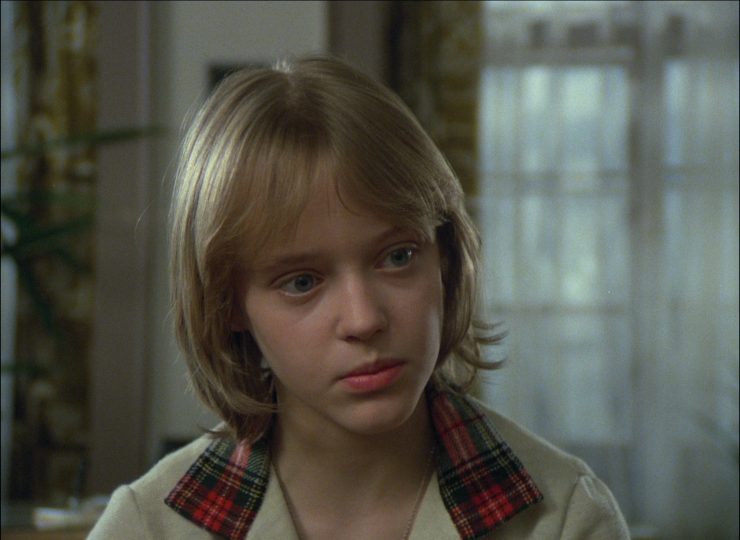The divorce rate in Czechoslovakia has been growing since 1950. The state responded by, among other things, setting up marriage counsellors and film production companies (Krátký film and Film Studios Barrandov) responded by frequently incorporating the topic into its dramaturgical plans. This trend didn’t slow down even during the period of Normalisation when The Girl with a Seashell was filmed. This intimate family drama by Jiří Svoboda in fact reflects two widespread sociological problems of the time, of which at least the second one is still relevant in the Czech Republic today: high divorce rate and alcoholism.
The adaptation of the novel of the same name by Jaromíra Kolárová tells the story of a family crisis and parental neglect from the point of view of a teenage girl. In a cramped apartment in Prague, fourteen-year-old Vendula must take care of the household and three younger siblings – Libor, Jeník and Venoušek – each of whom has a different father. Her divorced mother is unable to do so because of her addiction to alcohol manifested by ubiquitous almost empty bottles of liquor.
Almost every morning, Vendula also goes to clean an office instead of her mother who spends almost every penny on drinking. Whether alone or with various lovers she seduces in bars and takes them home. All this distress and responsibilities negatively affect the girl’s grades and she is seen as a slow student. She might also end up in a children’s home.
The fathers of her siblings don’t claim responsibility for their children. Vendula’s father has a new family and is well-off but she is adamant in her refusal to go live with him. She has a strong emotional bond with her brothers and mother, whose alcoholic excesses are escalating. She believes in her mother’s correction and her own power to keep the family together, making many sacrifices for this.
The girl displaying an unusual and even not-childlike sense of responsibility represents the very opposite of her egotistical mother who is unbalanced, loving, unable to give up alcohol and fleeting love affairs and even her rational and pragmatic father who, instead of love, gives her pocket money (which Vendula, despite her characterisation irresponsibly spends at a fair).
As the idealistic and altruistic Vendula, Svoboda cast Dita Kaplanová, who, after Karel Kachyňa’s Waiting for the Rain (Čekání na déšť, 1978), got another opportunity to give a heartfelt performance based on economical gesticulation and facial expressions. Although she was voiced by Sylva Sequensová due to her strong Brno accent, Kaplanová won the Jury Award of the Summer Workers’ Film Festival in 1981.
Evelyna Steimarová portrayed the role of the mother using theatrical gestures, shouting and unchecked anger. Alcohol seldom caused lethargy and depression. For most of the film, she is in an extremely exalted and unbearable state. But Steimarová’s performance reflects the way Miloslav Vydra’s script portrayed alcoholism. It is presented as a manifestation of a disturbed personality with no deeper social causes.
The depiction of the children’s homes may seem similarly simplistic. Svoboda visited many of them and talked to their directors, carers and children, but Vendula’s stay in an institution culminating in a frolicsome scene of a carnival parade seems unusually idyllic. That, however, corresponds to the subjectivity of the narration and the chosen stylisation.
While the film’s first part naturalistically depicts Vendula’s mother’s psychological breakdown and their shabby apartment with old furniture and empty food cans where the exhausted Vendula tries her best to maintain the illusion of a safe home, the second part is more lyrical, more subordinate to child imagination. It is in this part of the narrative when we finally see the titular motif of the seashell, in addition to many other symbols with which the film is almost overwhelmed.
The whole plot is interspersed with dreamlike sequences of family joy and wild rollercoaster rides representing Vendula’s unfulfilled desires and fears, but their frequency increases and under the influence of poetic ornaments and sentimental flute composition by Petr Hapka, the narrative becomes increasing romanticising.
Despite a certain over-aestheticisation, schematic characters of the parents and the didactic nature of the dialogue in which the characters explain their feeling, The Girl with a Seashell remains – mainly thanks to Dita Kaplanová – a fitting depiction of the loneliness some children experienced and still experience today in an insensitive and confusing world of adults unable to react properly to a child’s need for love and closeness.
The Girl with a Seashell (Dívka s mušlí, Czechoslovakia 1980), director: Jiří Svoboda, script: Miloslav Vydra, cinematography: Andrej Barla, music: Petr Hapka, cast: Dita Kaplanová, Evelyna Steimarová, Petr Bosák, Martin Zavadil, Dana Medřická, Emma Černá, Ladislav Frej st., Regina Rázlová, Jan Hartl, Eva Horká and other. Film Studios Barrandov, 87 min.


